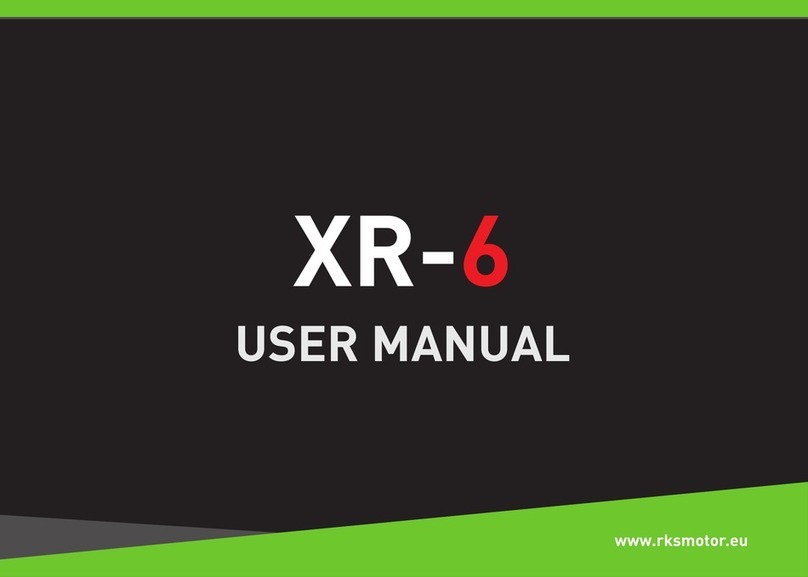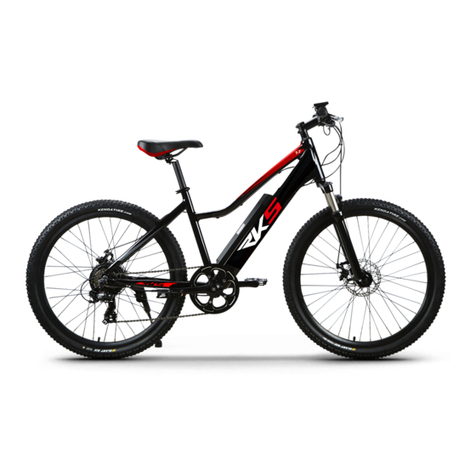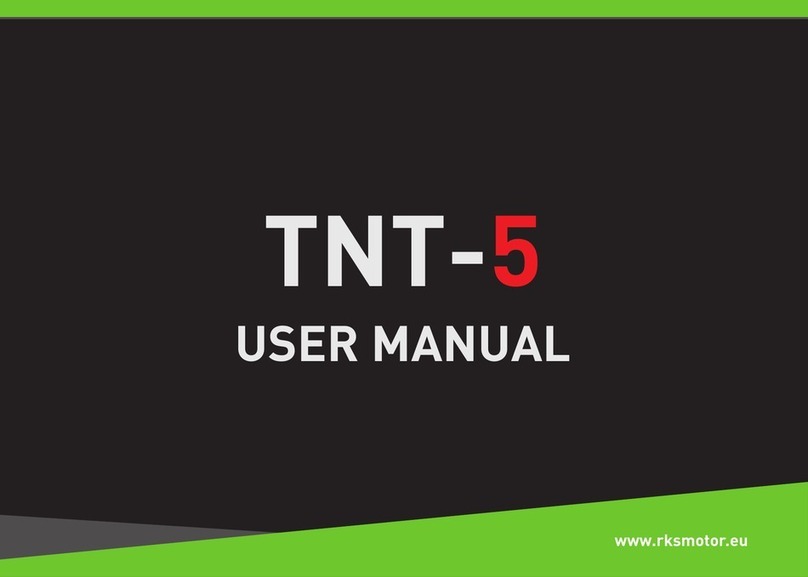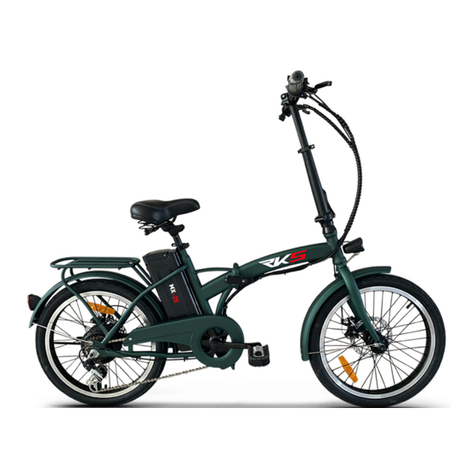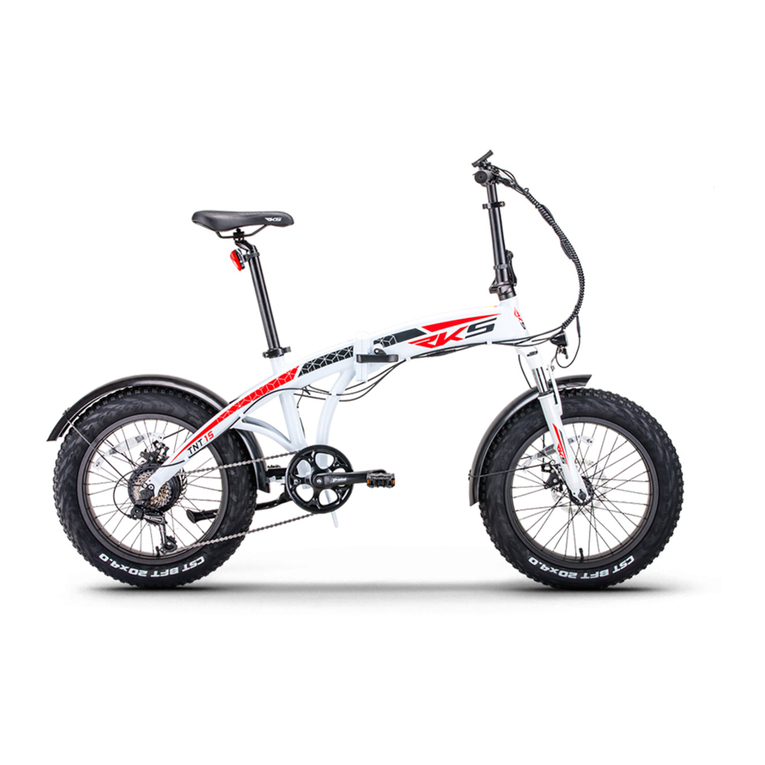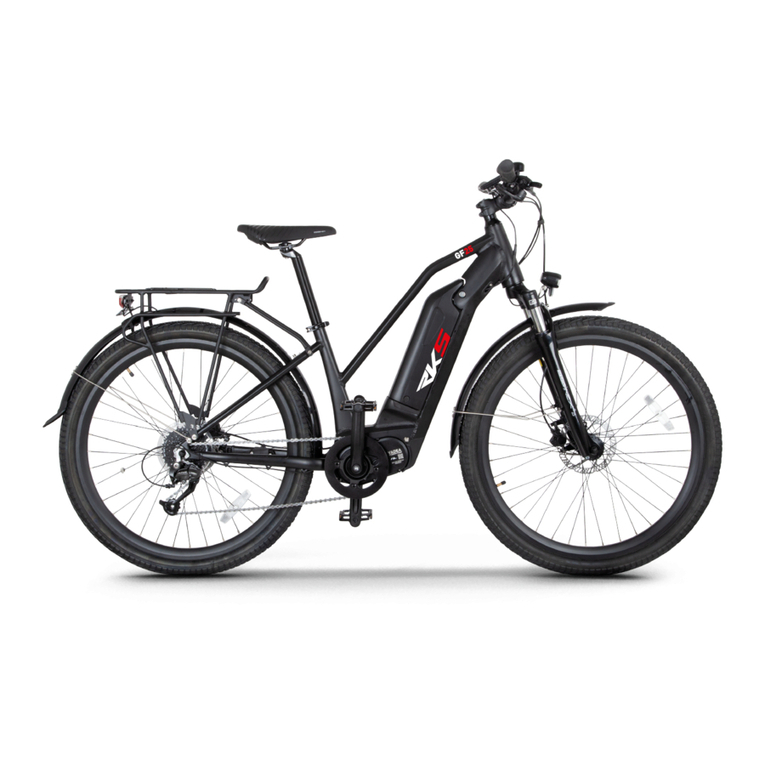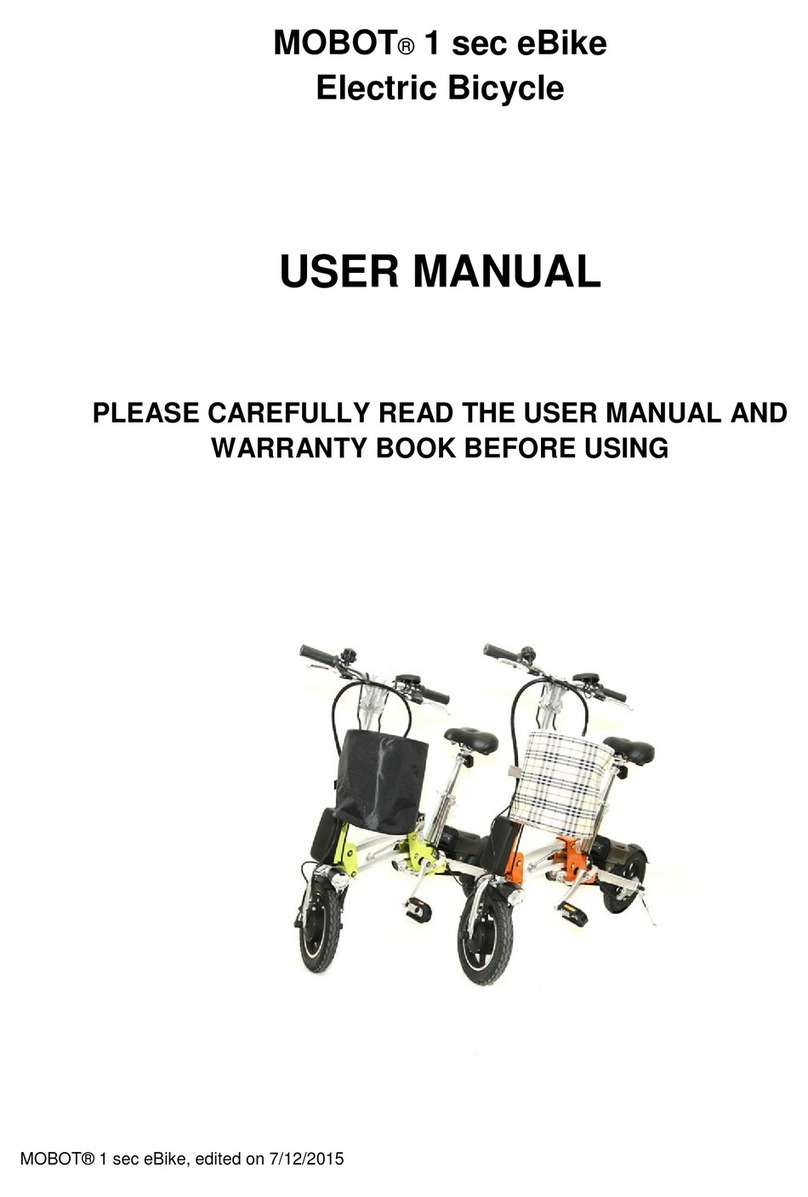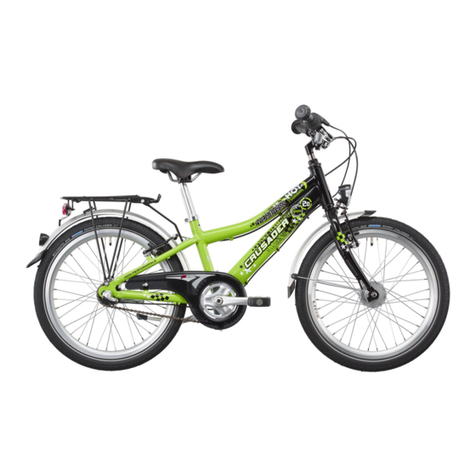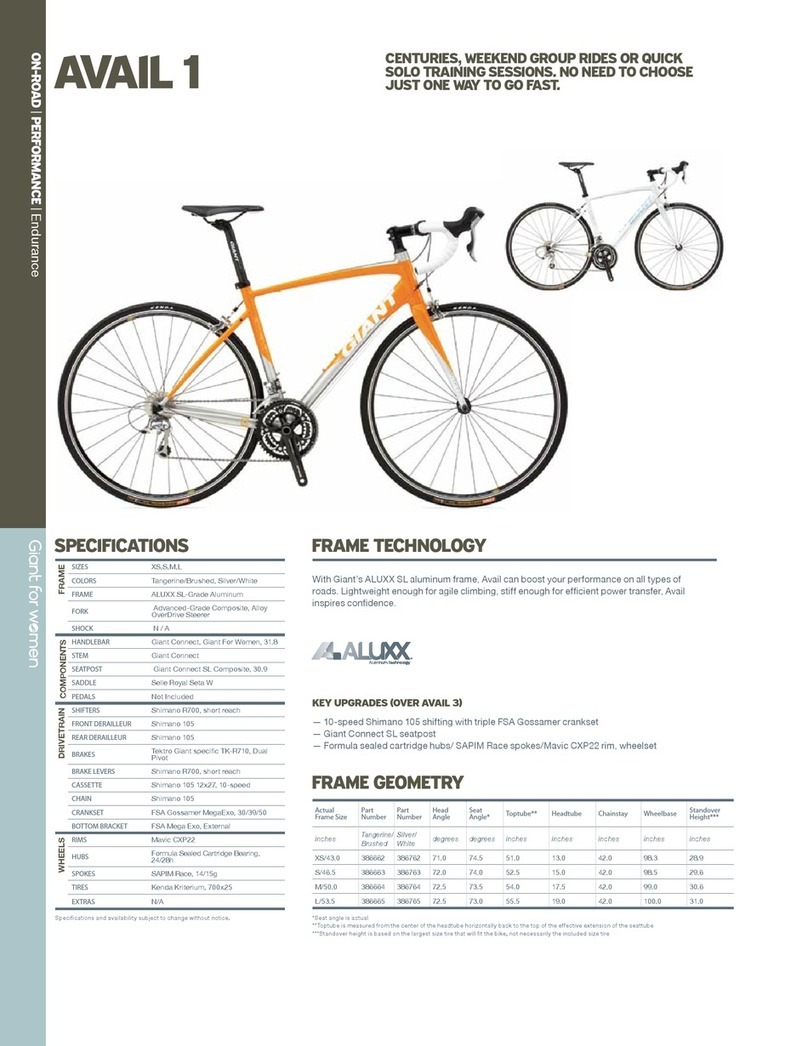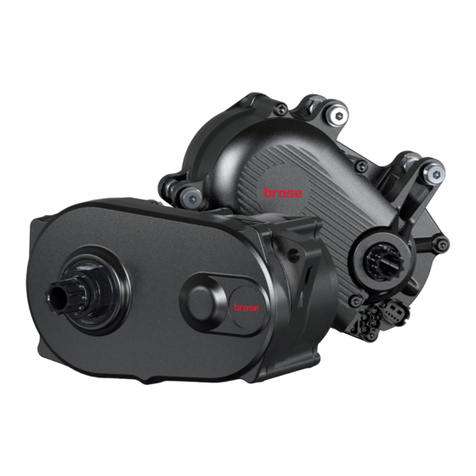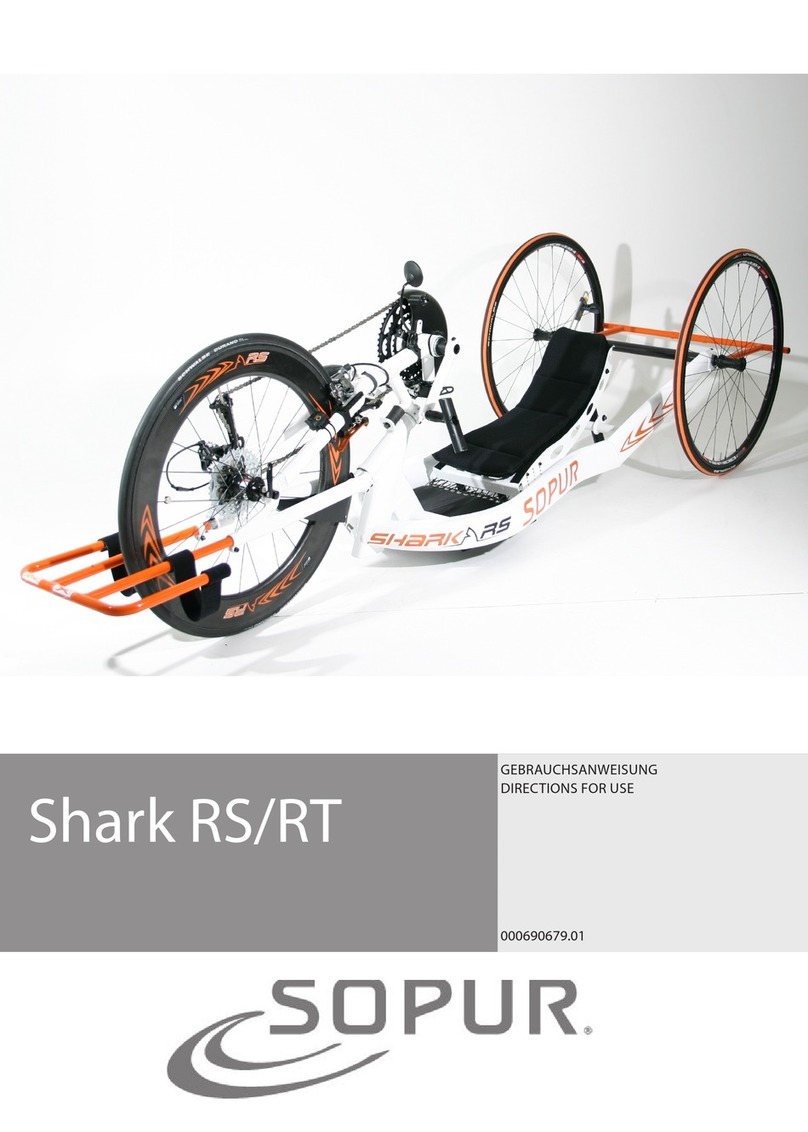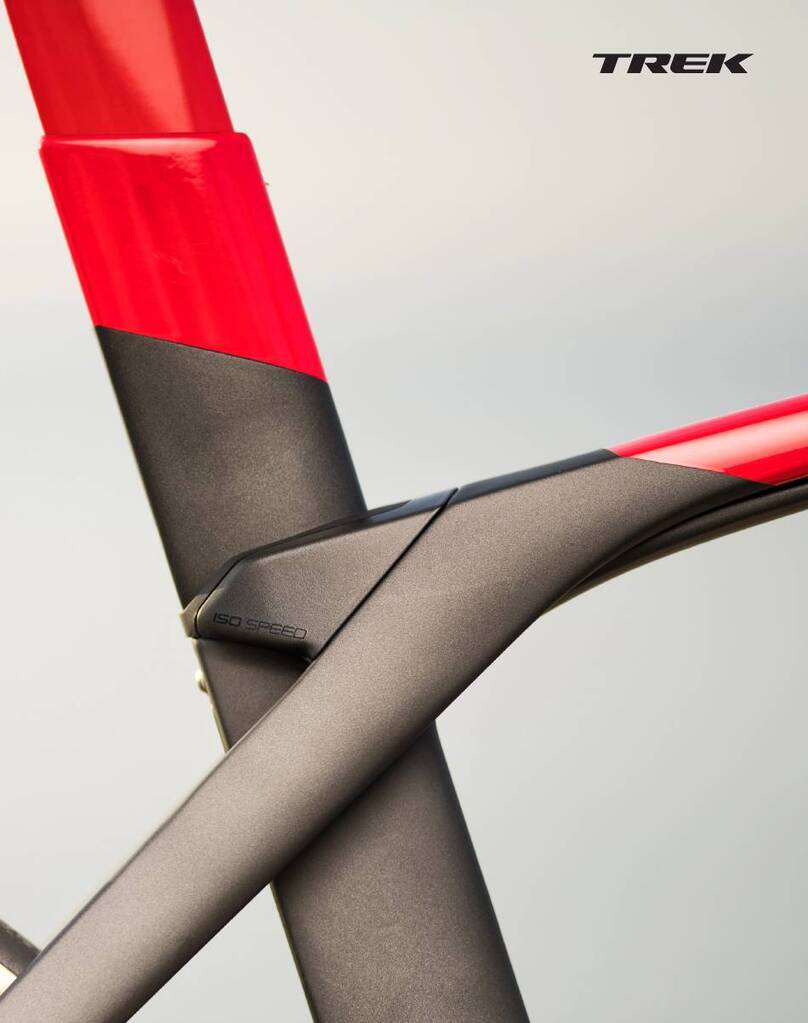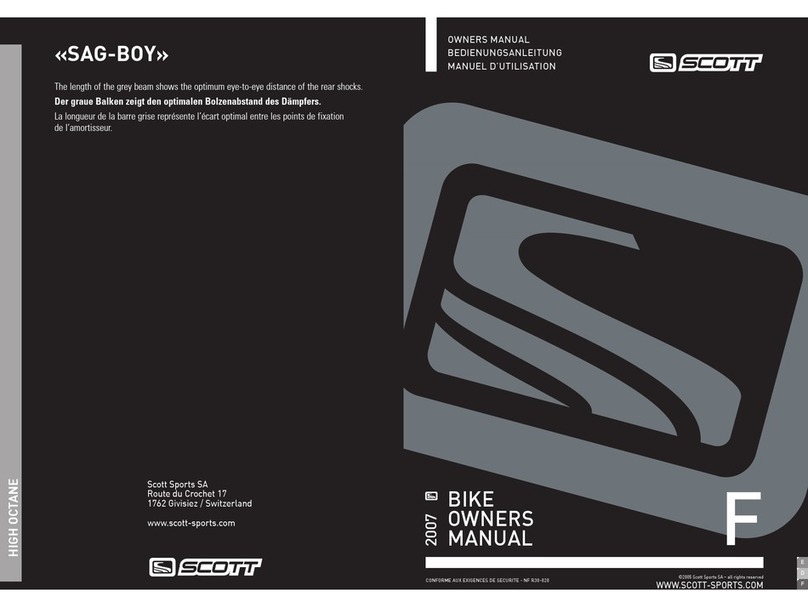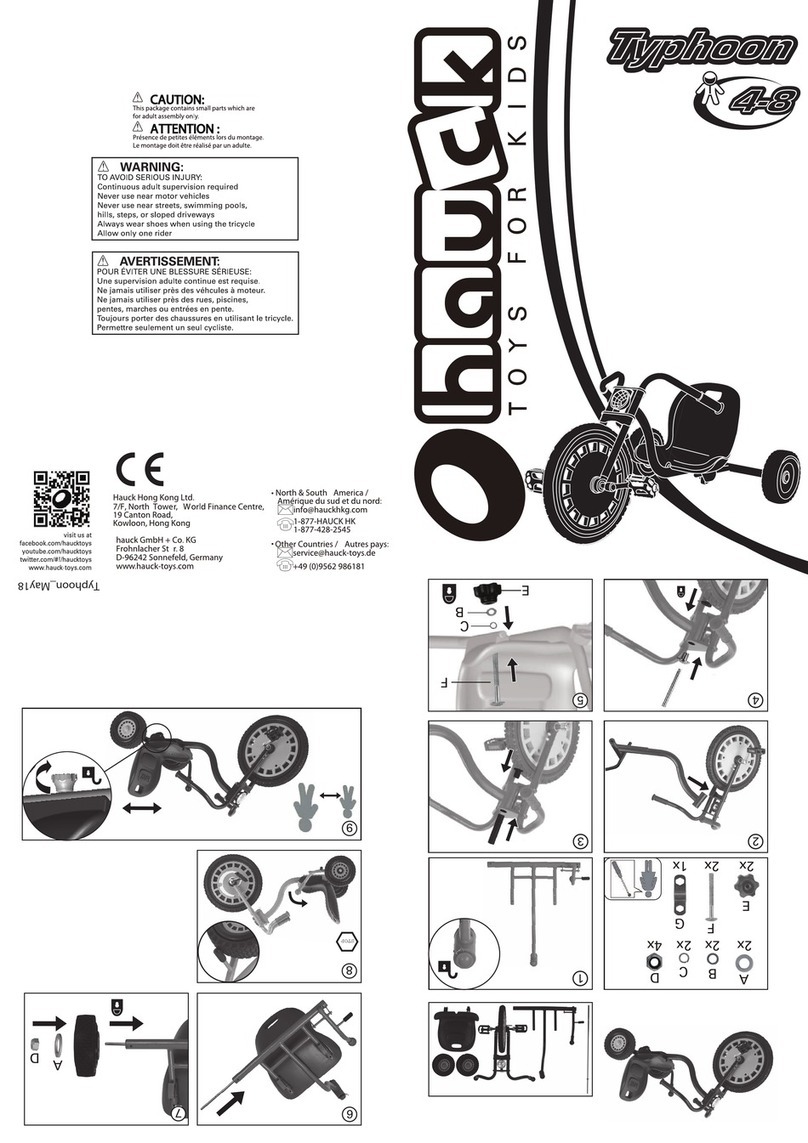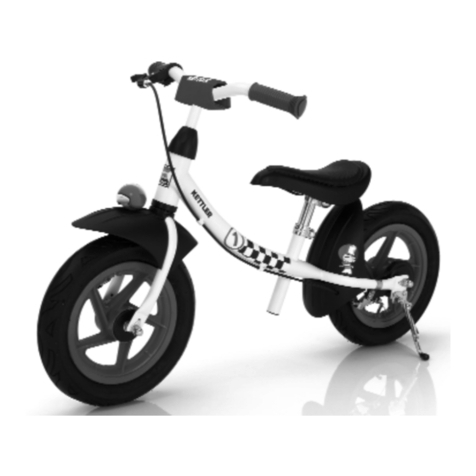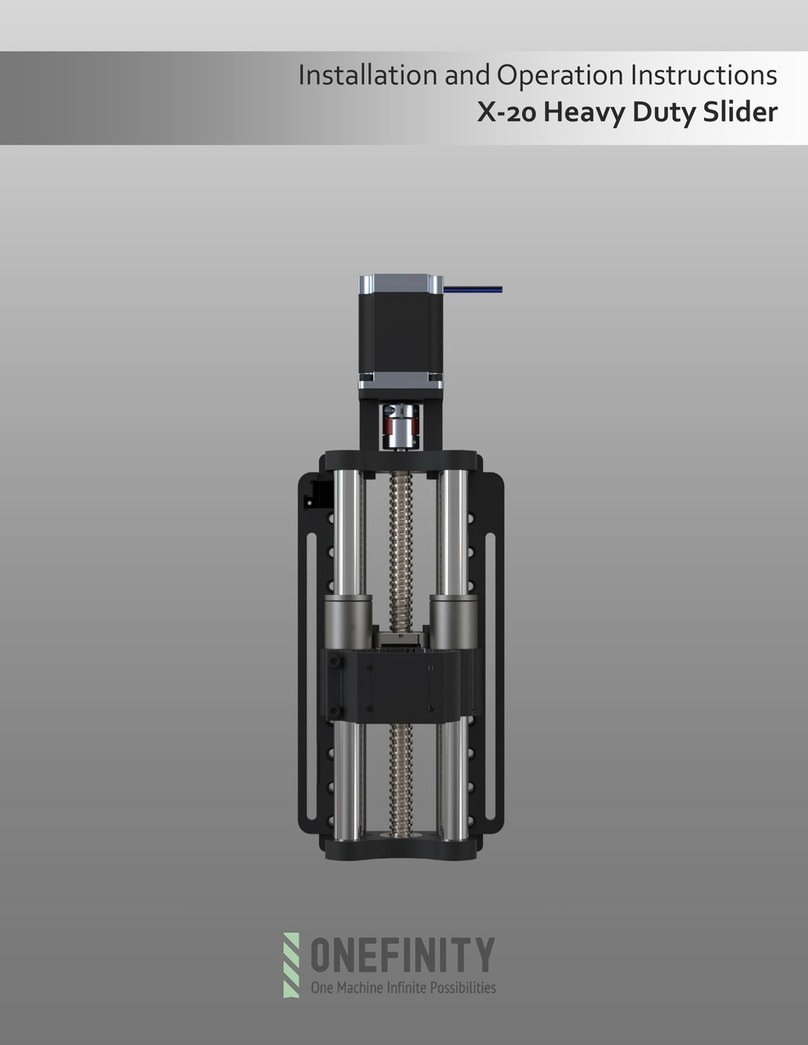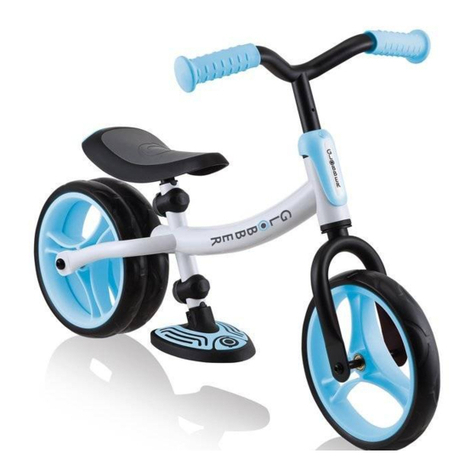RKS MC3 User manual

MC3
USER MANUAL
E-BIKE
www.rksmotor.eu


01
TABLE OF CONTENT
About Ths Manual
1. Why You Should Read Ths Manual?
2. Warnng, Important Safety Informaton
Dagram
1. Parts’ Dagram wth Parts Name
2. Wrng Dagram
Operatng Instructon
1. Important Notces
2. Rdng Mode
3. Rdng Safely.
4. Battery Chargng
5. Checkng the Battery Pack Before Frst Tme Use
6. Removng the Battery
7. Power Indcator
8. PAS (Pedal Assst System)
9. Throttle (If has)
10. Pedal Installaton
11. F E-B O F E-BHow to old the ike ( nly for olding ike)
12. Shfter (If has)
13. Deralleur System
14. Front Wheel-Quck Release
15. Brake Adjustment
16. Rear Carrer
17. Lght
18. Saddle Poston
Mantenance and Cleanng
FAQ
Servce & Mantenance Schedule
Problems and Remedy
About Dealer and Informaton Card

02
ABOUT THIS MANUAL
WHY YOU SHOULD READ THIS MANUAL
Ths manual s wrtten to help you to get the best performance, comfort,
enjoyment and safety when rdng your new E-Bke. The manual
descrbes specfic care and mantenance procedures that help protect
your warranty and ensure years of trouble free use. Please pay partcular
attenton to the secton on battery chargng and mantenance.
It s mportant for you to understand the features and operaton of your
new E-Bke so that you can get maxmum enjoyment wth maxmum
safety. By readng ths manual before you go on your first rde, you’ll know
how to get the most from your new E-Bke.
It s also mportant that your first rde on a new E-Bke be taken under a
controlled envronment, away from cars, obstacles and other cyclsts.
WARNING
Cyclng can be a hazardous actvty even under the best crcumstances,
Gvng Proper mantenance to your E-Bke s your responsblty as t
helps to reduce the rsk of njury. Ths manual contans many “Warnngs”
and “Cautons” concernng the consequences of falure to mantan or
nspect your E-Bke. Many of the Warnngs and Cautons say “you may
lose control and fall” Because any fall can result n serous njury or even
death, we do not repeat the warnng of possble njury or death whenever
the rsk of fallng s mentoned. Please note that those rsks are present.
Your E-Bke can provde many years of servce, fun and fitness-f you take
good care of t.
Understand the features of your E-Bke and become aware of the
challenges that you wll meet on the road. There are many thngs you can
do to protect yourself whle rdng. We wll offer many recommendatons
and safety tps throughout ths manual. The followng are those that we
beleve are the most mportant.

03
Always Wear a Helmet!
Helmets sgnficantly reduce the possblty and severty of head njures.
Always wear a helmet that comples wth your state laws when rdng the
E-Bke.
Check wth your local polce department for requrements n your
communty.
Do not wear loose clothng that can become tangled n the movng parts of
the E-Bke. Wear sturdy shoes and eye protecton. Also check your state
laws concernng other protectve wear that may be requred when rdng
the E-Bke.
Know Your E-Bke!
Your new E-Bke ncorporates many features and functons that have
never been bult nto a bcycle before. Read ths manual thoroughly to
understand how those features enhance your rdng pleasure and safety.
Rde Defensvely!
One of the most common cyclng accdents s that when the drver of a
parked car opens hs door nto a rder’s path.
Another common occurrence s when a car or another cyclst moves
suddenly nto your path. Always be aware of other vehcles around you.
Do not assume that drvers or other cyclsts see you. Get prepared to take
evasve acton or stop suddenly.
Make Yourself Easy To See!
Make yourself more vsble by wearng brght reflectve clothng. Keep
your reflectors clean and properly algned. Sgnal your ntentons so other
drvers and other cyclsts can notce your actons.
Rde wthn Your Lmts!
Take t slow untl you are famlar wth condtons that you encounter. Be
especally careful n wet condtons as tracton can be greatly reduced and
brakes less effectve. Never rde faster than condtons warrant or beyond
your rdng abltes. Remember that alcohol, drugs, fatgue and
nattenton can sgnficantly reduce your ablty to make good judgments
and rde safely.

04
Keep Your E-Bkes n Safe Condton
Check crtcal safety equpment before each and every rde.
Know the Law
Cyclsts are requred to follow traffic rules. Addtonally, some
communtes regulate the use of motorzed bcycles regardng mnmum
age requrements and necessary equpment. Check wth your local polce
department for specfic detals.
Correct Frame Sze
When selectng a new E-BIKE, the proper frame sze s a very mportant
safety consderaton. Most full szed bcycles come n a range of frame
szes. These szes usually refer to the dstance between the center of the
bottom bracket and the top of the frame seat tube.
For safe and comfortable rdng there should be a clearance of no less
than 1-2 nches between the gron area of the ntended rder and the top
tube of the bcycle frame, whle the rder straddles the bcycle wth both
feet flat on the ground.
The deal clearance wll vary between types of bcycles and rder
preference. Ths makes straddlng the frame when off the seat easer and
safer n stuatons such as sudden traffic stops. Women can use a men’s
style bcycle to determne the correct sze.

05
WARNING
Persons less than 16 years old (include 16 years old) are not allowed ride
e-bikes
for handle panel, it may vary from model to model, such as LCD and
LED panels in different design and function, and its user's manual may
be provided separately, accompanied with your bike.

06
Congratulatons
First of all, congratulation on your purchasing of our electric bicycle (or
pedelec), which is carefully designed and manufactured under strict
quality control according to the current European standard
EN15194:2017
Please read this instruction manual carefully and thoroughly before
riding, as it contains sufficient information, which is very important in
safety, maintenance and simple assembly. It is the owner's responsibility
for reading this manual before riding this bike.
The user's instruction manual includes two sections, one is mechanical
section, and another is electric section. This instruction is applied to the
electric bikes with following equipment:
For mechanical equipment:
•Derailleur/ Roller brake Derailleur/
• V-brake or disc brake
• Internal gear hub / Roller brake or coaster brake
• Internal gear hub / V-brake or disc brake
For mechancal equpment, an electrc bcycle dffers only slghtly from a
non-electrc bke.
For electrc equpment:
•The battery-pack wth rear carrer or on the down tube
•The motor n the rear or front wheel hub
•The controller on a box next to battery or ntegrated to the battery-
pack
•Operaton panel s nstalled to handle bar

07
SECTION I
MANUAL FOR MECHANICAL PARTS
Contents:
1. Conditions for Riding This Electric Bicycles
2. Selection and Set-up
3. Safe Cycling and Safety Tips
4. Routine Maintenance Check and Lubrication
5. Assembly Instructions
1.Conditions for Riding this Electric Bicycles
This electric bicycle is designed for riding on a road or a paved surface where the tires do not
lose ground contact, and this electric bicycle must be under proper maintained according to
the instruction of this manual. The maximum weight of the rider and load is required to be less
than 200lb (or 90kg).
Warning: You are warned that you take the consequences such as personal injury, damage,
or losses if you breach the above conditions and in the meanwhile, the warranty will be void
automatically.
2. Selection and Set-up
2.1. Saddle and Handlebar Stem Adjustment
The seat can be easily moved either up or down. Adjust the seat to keep the rider's knee
maintaining a slight bend when his foot is in the lowest pedaling position(refer to fig. 3).
Handlebar stem is approximately on the same level as saddle or slightly lower. For some
more adjustment tips, please refer to fig. 4 as below:
Warning: If your seat post is not inserted up to the minimum
insertion mark, the seat post may break (refer to fig. 5)
Once the saddle is at the correct height, make sure the seat
post should be up to its minimum insertion mark.
Warning: handle stem minimum insertion mark on traditional
quill stems must not be visible above the top of headset.
If the stem is extended beyond the minimum insertion mark the
stem may break or weaken the fork steering tube.

0108
3. Safe Cycling and Safety Tips
3.1 Checking Points Before Riding
Before you ride your electric bicycle at any time, make sure it is in a safe
operating condition. Particular check the following items:
• Electric bicycles nuts, bolts, quick-release and parts are fastened tight
and no worn or damage;
• Riding position is comfortable; Steering is free with no excessive play;
• Wheels run true and hub bearings are correctly adjusted;
• Wheels are properly secured and locked to frame/fork; Tires
• are in good condition and inflated to correct pressure Pedals
• are securely tightened to pedal cranks
•Gears are correctly adjusted
•All reflectors are in position
After you have made any adjustment to your electric bicycle, check that all
nuts and bolts are securely tightened and cables are free from kinks and
fixed securely to the electric bicycles frame. Every six months, your
electric bicycle should be professionally checked to ensure that it is in
correct and safe working order. It is the responsibility of the rider to ensure
all parts are in working order prior to riding this electric bicycle.
3.2 Do Not When Riding
•Do not ride without wearing an approved helmet, which must meet
European/USA standard or the same effect (comply with the law, rule
or regulations in your local area);
• Do not ride on the same side of road as oncoming traffic;
• Do not carry a passenger unless the cycle is equipped to do so;
•Do not hang items over the handlebars to impede steering or catch in
the front wheel;
• Do not hold on to another vehicle with another hand; Do not ride too
close to another vehicle.
Warning of Wet Weather Riding: No brakes work as well under wet or
icy conditions as they do under dry conditions. The braking distance in
wet weather would be longer than those in dry, and you should take
special precautions to assure safe stopping. Ride slowlier than normal
and apply your brakes well in advance of anticipated stops.

09
Warning of Night Riding: we recommend you minimize the times you
ride after dark. If you have to be out on your electric bicycle at night, you
must comply with the relative law, rule or regulations in your local area,
using a headlight(white) and taillight(red) on your electric bicycle in
addition to the all-around reflectors fitted. For more safety, wear light
colored clothing with reflective stripes. Check that the reflectors are firmly
secured in the correct position and clean and not obscured. Damaged
reflectors must be replaced immediately.
4. Routne Mantenance Check and Lubrcaton
Warnng: As wth all mechancal components, the bcycle s subjected to
wear and hgh stresses. Dfferent materals and components may react to
wear or fatgue n dfferent ways. If the desgn lfe of a component has
been exceeded, t may suddenly fal possbly causng njures to the rder.
Any form of crack, scratches or change of colorng n hghly stressed
areas ndcate that the lfe of the component has been reached and t
should be replaced.
Warnng: It s mportant to use only genune replacement parts for
several safety-crtcal components.
To keep the electric bicycle functioning well, the following routine
maintenance and lubrication is necessary for you
Half Yearly - Remove and clean, lubrcate chan, deralleur gears and all
cables. Check and replace as requred.
NB - Wash cycle weekly wth warm soapy water and dry t by rubbng wth
a soft cloth

10
Warning: When the rim becomes part of the brake system (such as the
conditions of V-brake and caliper brake), it is very important to check the
rim wear monthly and adjust the brake shoes accordingly to make the
clearance at 1-1.5mm from the track of rim. The wear of rim may destroy
the braking and result in personal injury to the rider or others.

11
5. Assembly Instructon
Here s some mportant nformaton for electrc bcycles assembly, whch
s very useful for your mantanng your electrc bcycle, and especally
helpful when you purchase our e-bkess whch s partly assembled and
packed n a carton.
Step 1: Preparation:
Take the electric bicycle and parts out of the carton and detach all parts
that are tied to the frame. Be careful not to scratch the frame or cut the tire
when removing the wrapping. And please do not rotate the handlebar
either until disassembly, otherwise it may break the cables. Then carefully
examine the carton for loose parts and make certain that no parts are left.
Step 2: Seat Assembly (refer to fig.7)
1. Loosen the seat clamp nuts(both sides)
2. Insert the seat post into the seat clamp. The seat post must extend at
least 1/4 inch(6-7mm) above the top edge of the seat clamp.
3. Re-tighten the seat clamp nuts on both sides(hand tight).
4. Push the seat post into the seat tube of the electric bicycle frame and
rotate the seat until the tip of the seat is directly above the top tube of the
frame.
THE SEAT POST MUST BE INSERTED INTO THE SEAT TUBE AT A
DEPTH WHERE THE MINIMUM INSERTION LINE IS NOT VISIBLE!!!

12
5. Open the seat post quck release
lever(Fg. 8). Insert the seat post nto the
seat tube to a sufficent depth so that the
mnmum nserton lne s no longer showng.
6. When you are satsfied wth the heght of the seat post, close the seat
post quck release lever. The tghtness of the lever s adjusted by rotatng
the adjustment nut opposte the quck release lever. Turn the nut by hand
to adjust the tenson whle holdng the lever stable.
Step 3: Handlebar & Handlebar Stem Assembly(refer to fig. 9 and 10)
As an usual stuaton, n our factory, the handlebar have been pre-
assembled together wth brake levers, shfter levers and grps. Be sure
that the longer cable s fixed to the rght lever (rear brake) and shorter
cable to the left (front brake), or accordng to your local rule and practce
(Note: In some area, such as UK, the cables are requred to be arranged
n the opposte way).
Snce your cycle may be fitted wth an adjustable, a standard stem or an
A- head stem(refer to fig.9 ), you must always check that all the bolts are
tght before cyclng. Based on the stuaton of standard handlebar stem,
please follow the nstructon below:
1. Push the handlebar stem nto the fork tube (head of the frame ) to the
mnmum heght lne that s marked on the sde of the handlebar stem. It
mght be necessary to loosen the expender bolt so that the stem can slde
nto the fork tube, untl you get your desred heght of the handlebar stem

13
2. Algn the handlebar stem wth the front wheel(see fig.10). Tghten
securely the expender bolt wth an adjustable wrench.
Note: Some models requre a 6mm allen key.(Tghtenng torque: 18N.m
or 14 footlbs.torque)
3. Loosen the handlebar clamp bolt and nut from the stem.
4. Poston the handlebar at the desred angle. Make sure that the stem s
n the center of the handlebar
5. Tghten securely the handlebar clamp bolt (Tghtenng torque: 18N.m
or 14 foot. lbs)
6. Be sure that your handlebar and stem assembles are properly tght
before rdng. The handlebar should not rotate n the stem. When you
straddle and grp the front wheel between your knees, the handlebar
should not be able to turn when you apply pressure horzontally. Refer to
(fig. 10)
Note: Under the stuaton of A-head stem, you make the smlar operaton
as the above. Compresson bolt tghtenng torque: 23N.m or 17 foot lbs.
torque; stem clamp bolt tghtenng torque: 12N.m or 9 foot. lbs
Step 4 Attachng Pedals(refer to fig. 11) :
1. The pedals are marked wth ether a “R” or “ L” on the threaded end of
the pedal axle.
2. Screw the pedal marked ”R” nto the rght sde of the crank assembly
(chan sde of electrc bcycles). Turn the pedal (by hand) n the clockwse
drecton. Tghten securely wth an adjustable wrench or the plate wrench
specal for pedals(Tghtenng torque: 34N.m or 26foot.lbs).
3. Screw the pedal marked “L” nto the left sde of the crank assemble.
Turn the left pedal (by hand) n the counterclockwse drecton. Tghten
securely wth an adjustable wrench or the plate wrench specal for
pedals(Tghtenng torque: 34N.m or 26foot.lbs).

14
Step 5 Brake Adjustments
The brake on your electrc bcycle should have been adjusted correctly n
our factory, however, as cables do stretch, t s mportant to check the
adjustment of your brakes after your first rdng. Most brakes wll need
some adjustment after beng used a few tmes.
V-brake Adjustment(refer to fig. 12) :
a. Press the nner cable through the nner cable lead, and after settng so
that the total of the clearance between the left and rght shoes and the
rms s 2mm, tghten the cable fixng bolt, tghtenng torque: 6-8N.m or 5-
6foot.lbs .
b. Adjust the balance wth the sprng tenson adjustment screws.
c. Depress the brake lever about 10tmes as n normal brake operaton
and check that everythng s operatng correctly and that the shoes
clearance s correct before usng the brakes.
Note: If you are still failed to well adjust the V-brakes, we strongly
recommend it being done by professionals. If the distance between the
left/right shoes and the rims is more than 2mm after abrasion for a long
time, you need to replace the left and right shoes to ensure the safety.
Basic Disc Brake Adjustment
The notes that follows are not exhaustive. If you need further assistance,
please take your cycle to your local dealer or a professional cycle shop.
a.Brake Lever and Brake Pad Travel Adjustment

15
You can alter the amount of braking pressure
by altering the travel of the brake lever and by
the proximity of the brake pads to the brake
disc.
To alter the travel of the brake lever adjust
screw A (see fig. 13), unscrew screw A reduce
the amount of lever travel and by tightening it
increase the lever travel. If you have fully
unscrewed screw A and the lever travel is still excessive you will have to
adjust the space between the pads and the disc.
Tighten screw A (Fig.13) up to the brake level. Go to Fig.14 and insert an
allen key into the smaller hole inside allen key hole B. Rotating the allen
key clockwise pushes the outer brake pad forward by approx.0.8mm After
each turn, check the braking performance.
Once the correct amount of travel has been reached, centre the brake
Calliper on the disc by adjusting screw C(Fig.15).when the brake pads
are centered on the disc the wheel should spin freely, though there may
be a slight amount of noise until the pads “bed” in.
If your cycle came from, or has recently been overhauled by a
professional repair shop. you should be able to maintain good braking
performance by adjuster screw C ( refer to Fig.15)
Once the correct amount of travel has been reached, center the brake
caliper on the disc by adjusting screw C (fig.15). When the brake pads are
centered on the disc the wheel should spin freely, though may be a slight
amount of noise until the pad bed in.

16
b. Brake pad wear and replacement
When you check your brake pads due to fallng performance, check ther
thckness. If they are less than 1 mm (Fg. 16), they wll need replacng.
To fit new pads, remove the brake callper from the fork or frame by
unscrewng allen bolts D(Fg.17). Unscrew (ant-clock wse), the smaller
allen bolt nsde allen bolt B(Fg.14). Lft up and pull the nner pad
downward, usng the protrudng part. Slde a thn slot screwdrver under
the outer pad and lft t up. Hold the screwdrver n ths poston and
remove the pad wth a par of longnosed plers.
Remove the sprngs from the worn out pads and fit them onto the new
pads. Replace the new pads, keepng them slghtly nclned nto the seat
of the Calper. Check that the sprng hooks correctly onto the small
pston.(When pullng downwards the pads should not come out).Refit the
Calper to the fork or frame and adjuster screw C(Fg.15)untl the pads
and the dsc are centered and the wheel spns freely. Agan there may be
some nose from the brake untl t “bed” n.
Step 6 Deralleur Gears Mantenance and Adjustment
To ensure that your deralleur gear works efficently and to prolong ts lfe,
t must be kept clean and free from excessve drt bult up and should be
properly lubrcated.
Note: If the specfic nstructon manual s provded accompaned wth
your bke, please follow t.
Before Adjustment, please make sure of the followng detals:
•The rght shfter controls the rear deralleur and sprocket.
•The largest rear sprocket generate low gear for hll clmbng; the small
rear gear sprocket develop hgh gear ratos for speed work and

17
downhll rdng
•The small chan rng produce low gear ratos whle the larger front
chan rng produce hgh gear ratos
•To operate your deralleur gear system efficently and reduce
damage, wear and reduce nose to a mnmum, avod usng the
maxmum crossover gear ratos of large chan rng/large rear
sprocket, small chan rng/small rear sprocket
Note: For postve gear selecton, observe these four precautons
1. change only when pedals and wheels are movng n a forward moton
2. reduce pedal pressure whle changng gears
3. Never back pedal when changng gears
4. Never force the gear levers
Rear Deralleur Adjustments:
Move the shfter all the way forward (toward seat) and wth the chan on
the smallest rear sprocket and largest front sprocket, check for cable
slack at pont “B” . If there s slack, loosen the cable nut or screw, pull on
the cable end wth plers and retghten the cable nut or screw whle pullng
cable taut(tghtenng torque: 5-7N.m or 4-5foot.lbs)
Top Adjustment
Turn the “H” adjustng screw(or top rear adjustment screw) on the gear
mechansm so that, lookng from the rear, the gude pulley s below the
outlne of the top gear.
Low Adjustment
Turn the “L” adjustng screw (or low gear adjustment screw) so that the
gude pulley moves to a poston drectly below the low gear
1. operate the shftng lever to shft the chan from top gear to 2nd gear.
•If the chan wll not move to the 2nd gear, turn the cable adjustng
barrel to ncrease the tenson 1(counter clockwse)
•If the chan moves past the 2nd gear, decrease the tenson
2(clockwse)
2. Next, wth the chan on the 2nd gear, ncrease the nner cable tenson
whle turnng the crank forward. Stop turnng the cable adjustng barrel
just before the chan make nose aganst the 3rd gear. Ths complete the
adjustment Be sure to perform ol mantenance at each part of the transfer

18
mechansm. The optmum ol s dry molybdenum ol or the equvalent.
Step 7: Tghten the front and rear hubs nuts securely.(Tghten torque:
about 30 N.m for front wheel, about 25 to 30 N.m for rear wheel )Before
rdng, lft the front of the bcycle so that the front wheel s off the ground
and gve the top of the tre a few sharp downward strkes. The wheel
should not wobble or come off.
Step 8: Inner gear adjustment, please refer to the attachment copy nsde
bke carton.
Table of contents
Other RKS Bicycle manuals
